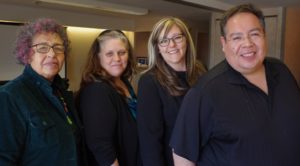Stressing importance of education for First Nations key to moving forward

By Rick Garrick
THUNDER BAY—Northern Superior Regional Grand Chief Pierre Pelletier spoke about the need for parity between on-reserve and off-reserve schools at the Anishinabek Nation’s First Nations Education Engagement Forum held on March 29 and 30, at the Valhalla Inn in Thunder Bay.
“The only thing I hope out of this [that] would be a real success story for me is if they could get parity, so a person going to school on a reserve is worth the same as a student going to school in town,” Pelletier says. “To me, if they could do that, that would be a huge success for the First Nation people.”
During the forum, Pelletier also spoke about the need to educate First Nation students on the importance of staying in school.
“It’s great that First Nations are starting to take control of their education and it’s about time,” says Biigtigong Nishnaabeg Councillor Sharon Ostberg. “We need to continue to move forward on that and let’s make sure that we’re doing it together.”
Ostberg says the regional makeup of the forum had its strengths and weaknesses.
“Because we’re all from within the same area…the dynamics of the group here were very similar,” Ostberg says. “It’s a lot different than when a person is from northern Ontario and a person is from southern Ontario. The dynamics are different.”
Ostberg stressed the importance of education for First Nations people.
“I remind people that we have to keep on top of this and keep on moving forward,” Ostberg says.
Murray Waboose, the new education director at the Union of Ontario Indians, says the forum was held to ensure community members from the Northern Superior Region had an opportunity to learn about the transformative changes being implemented by the government.
“We also wanted to make sure we had community input and dialogue with regard to some of these areas that we had discussed,” Waboose says, noting funding mechanisms, early childhood education and post-secondary education as some of the discussed areas.
Tim Hardy, a former community facilitator with the Union of Ontario Indians, looks forward to the changes.
“We’re finally bearing some fruit by having this new Anishinabek Education model for the communities to develop their own education act and policies, et cetera,” Hardy says. “Some of the people here are taking things forward now to bear some fruit.”
The forum also featured a questionnaire to gather input on the priorities for developing curriculum for the Anishinabek First Nation Education Administrators Program.
“We’re designing a one-year certificate program,” says Mary Laronde, consultant for the Anishinabek Educational Institute. “This will be an on-line program because everybody is so busy. As Murray mentioned earlier, there will be some workshops attached to that where we could meet face-to-face and do work like that.”
Laronde says the questionnaire was also sent to all of the Anishinabek First Nation Education Administrators.
“So this is an idea to have resources, mentoring, professional development credits, workshops, et cetera in an actual program that could be applied as additional qualifications for a certificate,” Laronde says. “And eventually the plan is to actually have a diploma program. So it could be a First Nations administrator diploma with a focus on education.”


